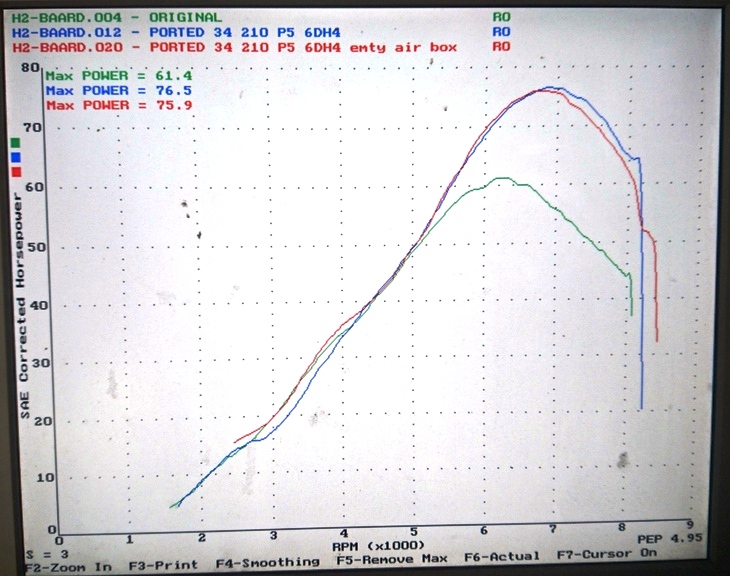
Exhaust Port Mod - jyrg
Below
is a image of my exhaust port versus stock port. All
measurements are dependent on which bore you have.
That's why we always do this measurements in % of chordial bore, and exhaust
duration in crankshaft turning degrees.
To be on the safe side, you keep the chordial to less than 70%, and to get
power: More than 68%...70% of max
bore is 51,5mm. If you go 51.5mm on a standard bore 71mm cylinder, you end up
with 72,5 %, and MAYBE a wrecked cylinder)
And you don't want that, just ask me: I have wrecked 2 sets of cylinders in my
search for the results that I have.
Anything between 185 and 193 (maybe more) degrees duration will work. As said, I
have tried 188 and 193. The 193 set that had its liners broken, had double of
stock rwhp. (stock is usally between 60-65 rwhp)

If you look at the image, the extra area added by the more square port versus a
port with same height but with stock profile may not seem significant.
But I believe it is, and here's why:
During the critical blowdown phase (it is critical because it determines the
pressure inside cylinder at the time the transfers opens. The lower the pressure
versus crankcase pressure, the better the flow off course), it is of MAJOR
interest WHERE that area is.
Going as square as possible gives you as much area at the UPPER part of exhaust
port WITHOUT the need of increasing height.
WHY is it a good thing having area on upper part of exhaust port versus at for
example the middle part of the port???
Because the upper part is OPEN AT ALL TIMES during blowdown. In other words (I
have not done any math on this, this is just an explanation) : Let's say the
square profile adds 50 mm squared at the upper 10 % of the port. That may equal
to let's say 150 square mm at the mid part of port, due to the upper
explanation.......the upper part is open at a lot longer period of time.
Ok.....if you raise your exhaust port, let's say 1,5mm more than the square
port, then you have maybe about same area on the upper 50% of port as with the
square port. BUT.....you have raised duration a lot, and that is NOT a good
thing for low end power as the power stroke is reduced.
Your engine is also going hotter. Not good on a powerful air cooled triple.
Ok...some might say (which is correct) that a ex port with higher duration gives
a harder exhaust pulse, thus a more powerful returning wave, thus more power in
powerband. BUT.....a squarer upper
profile does just the same thing, but is a "COOLER" way.
That results in some cooler exhaust gas temp, but with maybe the same strength.
(this is important for non-adjustable ign systems).
With a lower exhaust gas temp, the pipe MAYBE gets a bit cooler, thus the waves
goes slower, thus you enter powerband a bit earlier. (but ok, you loose some rpm
on top for same reason).
But this post is not for making as much peak power as possible. It's for making
as much of a streetable triple as possible, and still a whole lot of peak power
as long as you use big carbs, good heads and good pipes and have the port work
done in a good manner).
The increased blowdown area is first of all useful at higher revs. Where your
torque starts dipping with low blowdown area, added area will reduce the torque
falling after let's say 7000 rpm, and give you a close to flat torque curve,
thus you gain much power due to hp = torque x rpm
The image is not very accurate. The stock profile is a bit more rounded, but it
gives you a clue about what I am trying to say.
And it works.
Regarding ring life, I run 70% chordial width. In fact, now I am running 71% as
a test. (done that for about 2000 km's).
I don't know anything else about ring life that 2000 km is not a problem at all
(port is nicely rounded), and no ring snagging in port. The radius seems to be
good enough for Wossners.
Sorry for my sketchy English. feel free to ask questions. I have said it
earlier, and I say it again: I may be wrong is some cases, but I try to hand out
what I believe is the correct info.
I know, after I have seen old school ported H2 cylinders, that the ex port often
were about 65% width, and with a lot higher exhaust duration than my 188-ish. To
compensate for the small 34mm carb, inlet duration also was raised a lot,
sometimes by chopping off 5-6mm of piston skirt. That
is a recipe for a lame low end, and probably also not as strong peak power
figure as the Neville Lush way.
Have you guys seen the video I made, 5th gear launch without clutch abuse, where
you can see she pulls from 8-900 rpm in high gear?? I think that video (using
39,2mm TMX) tells the story quite well, and kind of shows that a piston port
high output big flatslide carbed H2 can be VERY streetable.
Below dynosheet is shown to describe the importance of blowdown given by widening the port, mostly.

It has a 0,5mm cylinder raise, and another 0,5mm port raise, a total of only
1mm.
Same port design as above, 70% width.
As one can see, the combination of 34mm carbs AND the increased blowdown has a
nice impact on power in the upper powerband.
From what I have seen, the 34 versus 30mm carb alone, makes about 5 (?) extra
rwhp.
The rest is mostly due to the increased blowdown.
And no, the inlet duration is not compensated for after the tiny lift.
And yes, blueprinting and the tiny lift of transfers also gives a little extra
power.
But as said: The major reason for the power increase is related to blowdown.
Jørgen